From January 5 to 11, 2013, JICA President Akihiko Tanaka visited Brazil and Peru. Tanaka held talks with prominent figures, including discussions with Brazilian Vice-President Michel Temer and Peruvian President Ollanta Humala Tasso. He also visited the Cerrado and São Paulo State police in Brazil. In Peru, he signed two Japanese ODA (Official Development Assistance) loan agreements and also toured sites such as the Lima Marginal Areas Sanitary Improvement Project supported by a Japanese ODA loan.
The Ethnic Japanese “Nikkei” Community – One of Japan’s Greatest Assets
With the sixth largest economy in the world, Brazil is a powerful emerging nation, as well as home to the largest Japanese “Nikkei” community in the world outside of Japan. With a growing impact on economic relations with Japan and other partner countries, Brazil is also contributing to the international community. The country is also a presence capable of having a strong influence on global issues such as the environment, climate change, resources, energy, and food security. It should be also noted Brazil is one of the countries with largest income disparities in the world.
On January 5, Tanaka arrived in São Paulo, Brazil’s largest city. He exchanged words with a Japanese-Brazilian organization on such topics as relations between JICA and the ethnic Japanese community, activities of JICA volunteers, and development of the next generation in the community. Afterward, he toured a “koban” of the São Paulo State police, which was established through technical cooperation by JICA.
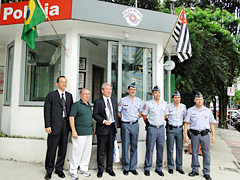
JICA President Tanaka (third from the left) visited São Paulo State koban supported by a JICA project with the cooperation of the National Police Agency of Japan.
On January 6, Tanaka toured projects, including a JICA financed project on the Tietê River, and held a press conference. Tanaka stated that the influence of Brazil is rapidly rising in the world. As a country with resources and agriculture, Brazil has become one of the key countries on the market, economic and political fronts. He also said that the ethnic Japanese community of Brazil is one of the greatest assets that Japan has overseas. Giving the example of PRODECER, the Japan-Brazil Agricultural Development Cooperation Program, [Note 1] Tanaka said, “It is significant to have another grain belt alongside North America in the world. It is important for JICA, as a long lasting partner, to be involved. I understand that international cooperation and collaboration with the Japanese community has crystallized here. Going forward, I hope to provide cooperation in such a form that builds partnerships with the private sector.”
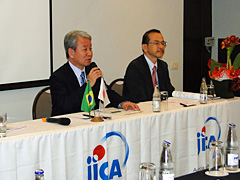
Tanaka (left) discusses JICA’s cooperation in terms of both volume and quality.
On January 7, Tanaka traveled to the capital Brasília. First, he visited a Japanese-Brazilian farm settled through the PRODECER project where he saw corn and coffee cultivation areas made possible by center pivot irrigation, [Note 2] as well as gathering and storage facilities for garlic. He also looked over the Cerrado from an aircraft. Through these observations, Tanaka again reassured the importance of agriculture and land development in Brazil, and the size of the contributions to the world’s food security.
He then held successive talks with Marco Antonio Raupp, minister of Science, Technology and Innovation, and Fernando Pimentel, minister of Development, Industry and Trade, in which he discussed issues such as technical cooperation on disaster risk management and the importance of partnerships with the private sector through capacity building of human resources in industry.
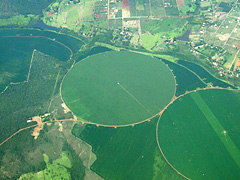
Enormous, round areas of arable land with a radius between 400 and 500 meters (taken from above the Cerrado)
The Importance of “Triangular Cooperation”
On January 8, Tanaka held talks with Antonio Patriota, minister of External Relations, and Fernando Marroni de Abreu, director of the Brazilian Cooperation Agency (ABC). He visited a PRODECER farmer and said he can clearly see that JICA’s cooperation has provided positive development results, and he would appreciate further cooperation for the ProSAVANA-JBM Project [Note 3] which has moved forward with triangular cooperation among Japan, Brazil and Mozambique since 2009. Patriota responded, “We have a challenge to delivering results with a limited budget, but ProSAVANA will likely be a good example of cooperation between the Governments of Japan and Brazil.” Patriota also expressed his desire for JICA to share its experiences in supporting the private sector.
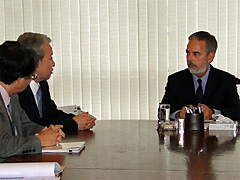
Tanaka (second from left) holds a discussion with Antonio Patriota, minister of External Relations.
Next, Tanaka held a talk with Vice-President Temer. After Temer described policies focused on improving the income of some 40 million people who live in poverty, Tanaka shared his view of cooperation for the private sector such as human resource development in shipbuilding and other industrial sub-sectors. Tanaka also agreed to the importance and mutual benefits of triangular cooperation to regions such as Africa, as well as the scale of contributions that the ethnic Japanese community has made in Brazil. Tanaka noted that Japan’s cooperation to Brazil is focused on triangular cooperation, urban problems, and the environment and disaster risk management, and that JICA would move forward with cooperation along this direction.
Tanaka then headed to his next destination, Lima, the capital of Peru.
Toward Realizing Social Inclusion
Facing the Pacific Ocean, Peru has strengthened relations with Pacific Rim countries in recent years as an exporter of minerals and fish resources, and has an important relationship with Japan. Peru has maintained one of the highest rates of economic growth in Latin America over the past decade. However, improvement of the lives of the poor, primarily in the mountainous area, remains a priority issue. Regional development is moving forward through economic and social investment by leveraging the Kuelap ruins in northern Peru as a tourism resource, which is lesser-known and less developed compared with the Machu Picchu ruins. Peru is also home to an ethnic Japanese “Nikkei” community numbering 90,000 people derived from Japanese immigration which started 113 years ago.
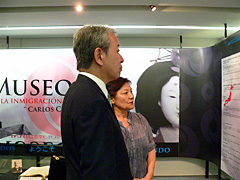
Tanaka tours an immigration museum located in Jesús María, a district in Lima.
After arriving in Lima on January 9, Tanaka held discussions with Abel Fukumoto, president of the Peruvian Japanese Association, and José Arista Arbildo, president of Amazonas Region, among others. After touring the immigration museum and other locations, Tanaka attended a meeting with Peruvian President Humala.
President Humala said, “JICA is the most important partner for Peru as a bilateral cooperation agency. Recently, Peru has experienced frequent earthquakes, and we strongly hope for further cooperation that incorporates the knowledge and experiences Japan has in disaster management.” In response, Tanaka said, “With respect to disaster measures, we are currently working on a project to enhance disaster mitigation technology in the SATREPS [Note 4] framework, and hope to expand such cooperation.”
Also attending the meeting was Luis Miguel Castilla, minister of Economy and Finance, who mentioned that Peru is pursuing policies not only for steady economic growth, but for education, health and other social inclusion issues, [Note 5] and that those policies are very crucial for the country. President Humala then announced his hope for on-going cooperation for reducing poverty through measures such as environmental protection and water and sewer infrastructure, and his interest in a standby ODA loan [Note 6] for disaster management.
At the signing ceremony for the ODA loan agreements, Tanaka said, “JICA is working on improving the livelihoods of residents, alleviating poverty, environmental protection and other issues in developing countries under JICA’s vision “Inclusive and Dynamic Development”. The loans we sign today are for comprehensive regional development through rehabilitating water and sewer networks, and promoting sightseeing. These loans also uphold the social inclusion touted by the Humala administration and JICA’s vision.”
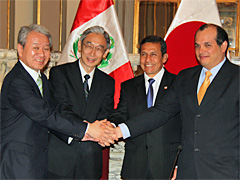
(From left to right) Tanaka, Masahiro Fukukawa, Japanese Ambassador to Peru, President Humala and Luis Miguel Castilla, minister of Economy and Finance shake hands after signing
Ties between Neighboring Nations Across the Pacific
On January 10, Tanaka visited the National Institute of Rehabilitation (INR) in the Chorrillos District of Lima. After observing the status of facility building by grant aid, he visited Huaycán on the outskirts of Lima, which is the target area of the Lima Marginal Areas Sanitary Improvement Project, to see a water storage tank among others. This project accomplished the connection of all households to the water and sewer systems in a region with steep slopes through efforts to educate and organize residents.
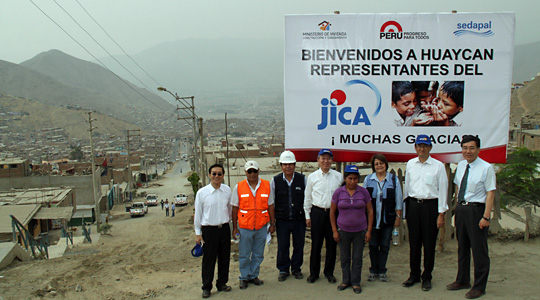
Tanaka (fourth from left) stands in front of a project sign in Huaycán, a suburb of Lima. In the background, the townscape spreads out over a steep slope.
On January 11, he toured the Peru-Japan Seismic Investigation and Mitigation Center (CISMID), established 25 years ago in a JICA project. CISMID, located in the campus of Peru’s National University of Engineering, is the site of the current SATREPS Project for Enhancement of Earthquake and Tsunami Disaster Mitigation Technology in Peru. Even today, CISMID plays the primary role of earthquake disaster risk management in Peru. He also exchanged opinions with CISMID staff members.
Afterward, Tanaka stated at a press meeting in JICA Peru Office, “Although Peru is geographically distant from Japan, we have strengthened our understanding that we are neighbors across the Pacific Ocean. I believe that as relations between Japan and Peru grow closer, JICA’s role will become more important. Sustainable economic growth with social inclusion—that is, all people can enjoy the fruits of growth—is vital, and I will promote cooperation to encourage socioeconomic development in line with this concept."
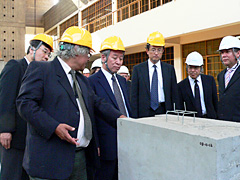
Tanaka (third from left) listens to an explanation on an experimental device at CISMID.
Notes
- 1 . In the 1970s, Japan suffered dramatically from a steep rise in grain prices, and with the objective of diversifying their food import sources beyond the dependency on the U.S., Japan began providing assistance for agricultural development in 1979, primarily for soil improvement in the Cerrado, where the land was said to be barren.
- 2 . A type of irrigation that supplies water in a circular form from a self-propelling sprinkler that extends from the center. A rotating sprinkler arm is placed at the center of an arid land area so crops can be cultivated.
- 3 . A tropical agricultural development program in Africa in which JICA used its development experiences conducted with Brazil in the Cerrado for development in the Nacala Development Corridor in northern Mozambique.
- 4 . Scientific technical cooperation for global issues. Japan (JICA and the Japan Science and Technology Agency) partners with universities and research agencies in partner countries on collaborative research to solve global issues such as those pertaining to the environment, energy, disaster preparedness and infectious diseases.
- 5 . A concept of social welfare in which all people are protected from loneliness, isolation, exclusion and friction, and they are included and support one another as constituent members of society so as to realize healthy, culturally active lives.
- 6 . Japanese ODA financing that can be immediately utilized as funds when the need arises such as when a disaster strikes.




scroll